

This type of split tunneling is especially useful for apps that primarily use the local area network or need access to local network resources. All of the rest of the traffic will travel through the VPN tunnel. The user can select or “whitelist” which apps should not use the VPN tunnel. Some VPNs offer the functionality that allows using it for specific applications.
#Pptp vpn application for mac how to
How to Use VPN Only for Specific Applications However, things get more complicated when you want to be able to take advantage of the security of a VPN while also having access to an open network. It is certainly no problem to temporarily switch off your VPN.

There are many circumstances when you might want to bypass your VPN for specific applications or particular sites. You may also want to bypass your VPN when you need to access local network resources like files or a network printer. VPNs can cause a slight reduction in speed and an increase in latency. You might want to go around your VPN when speed is more important than security. Here are some examples of why you might need split tunneling. But what if you want to use your VPN for only specific apps or specific websites? What if you want some of your traffic to be routed through the VPN and the rest through your standard open network connection? For that, you will need split tunneling. Standard VPN connections route all of your traffic through the encrypted tunnel. However, with some VPNs, you are stuck with an all or nothing solution. From this menu, you quickly start and stop your VPN session without navigating though the ‘System Preferences’ menu.You count on your VPN to keep your online life secure and private. For a quick way to access your VPN session, locate the the indicator on the top of the screen – look for the session ‘Connect Time:’ indicator, and click to open a context menu. Step Twelve: You are now connected and secured. Step Eleven: Test your newly created connection by clicking the ‘Connect’ button, just below the ‘Authentication Settings…’ button, and move on to the next step. Tick the third checkbox down, labeled ‘Send all traffic over VPN connection’, then click the ‘OK’ button in the lower-right corner to continue. Step Ten: In the ‘Advanced’ settings pane, locate the ‘Session Options’ category. Click the ‘Advanced…’ button to continue. Step Nine: When you return to the previous menu, locate the ‘Advanced…’ button in the lower-right corner, next to the question mark icon. As before, this field is case-sensitive, so double-check against the confirmation email we sent you at sign-up.
#Pptp vpn application for mac password
Step Eight: In the resulting dialog, enter your VPN Zoom password in the ‘Password’ field. Finally, locate the ‘Authentication Settings…’ button, and click to move on. Fill your username in the ‘Account Name’ field – remember that all usernames end with Confirm that the ‘Encryption:’ drop-down box is set to the default ‘Automatic (128 bit or 40 bit)’ setting. A complete list of our VPN servers can be viewed here.

Please reference our server list for more details. Step Seven: Once the new connection profile is made, fill in your selected VPN Zoom server address in the ‘Server Address’ field – when choosing a server to connect to, geographical location may be a concern. Step Six: Finally, enter a descriptive name in the ‘Service Name’ field below – this field can contain whatever descriptive title that meets your needs. As this tutorial covers the PPTP protocol, select the ‘PPTP’ item from the drop-down menu, and move on to the next step. Step Five: Once you’ve assigned the interface type, click the second drop-down box that appears below, labeled ‘VPN Type’. In the drop-down context menu, locate, and select the item labeled ‘VPN’ to continue. When the resulting dialog appears, look for the ‘Interface’ drop-down box, and click. Step Four: To create a new connection profile by clicking the square ‘+’ (Plus) button as shown in the image. In this category, locate the ‘Network’ icon, and click it to move on. Step Three: Within the ‘System Preferences’ menu, locate the ‘Internet & Wireless’ category. Alternatively, you may click the ‘System Preferences…’ icon in your dock to continue. Click the ‘System Preferences…’ item and move on to the next step. Step Two: Click the Apple icon, and in the resulting context menu, locate the ‘System Preferences…’ item. Locate the Apple icon in the upper-left corner of the screen, and continue to the next step. Step One: Minimize or suspend any running applications, and activate your main desktop, or ‘Finder’. If you have any questions about setup please contact our support team. If you’d like to manually configure OS X the following guide shows how to setup a PPTP VPN connection. We recommend using the EZConnect Connection Manager for accessing our VPN service with your iMac.


 0 kommentar(er)
0 kommentar(er)
